Today's equation is: Styrofoam plus pressure equals fun!! We are almost done with the cruise; we will be done with collecting samples by early morning tomorrow. This means it is time for the long held tradition of sending decorated Styrofoam items to the bottom of the sea along the rosette. Here are the two cups I will be sending, one for each of my kids.
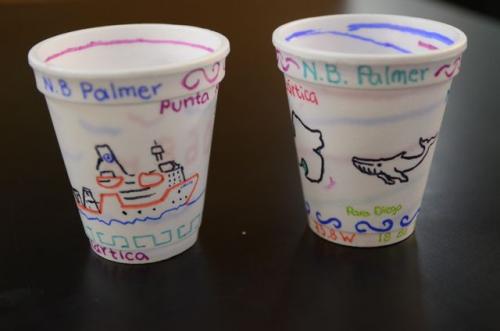
Why would we want to paint Styrofoam cups and send them to the bottom of the ocean? Here is the not quite short explanation.
Pressure is defined as a force acting on a given area (Pressure = Force / area). A force is a push or a pull on an object. Your weight, for example, is the force with what you are being pulled by earth. We can define the pressure you exert on the ground as your weight on the area that is in contact with the ground. If you are standing up, that areas is the sole of your shoes. If you are laying down, the area is the surface of your head, arms, back and legs touching the ground. Since the area is bigger when you lay down, is the pressure you are exerting on the ground bigger or smaller than when you are standing up?
Styrofoam is a bunch of air bubbles enclosed in a plastic, like tiny inflated hard-shell balloons. Imagine an inflated balloon. There is a difference in pressure inside and outside the balloon, and the balloon will not pop as long as this difference in pressure is smaller than the resistance of the rubber membrane. Imagine you now sit down on an inflated balloon. What do you think will happen? The balloon will pop! You have increased the pressure outside of the balloon so much that the difference in pressure between the inside and outside is larger than what the rubber in the balloon can tolerate and bursts.
The same happens with the air bubbles in the styrofoam cup (or any other object made out of Styrofoam, for that matter). The bubbles do not burst as long as the difference in pressure between the inside and outside of the bubbles is smaller than the plastic's resistance. The bubbles will burst like the balloon as soon as the pressure difference goes beyond that resistance. Styrofoam can tolerate somewhat large pressure differences, otherwise the bubbles would burst when you add water in the cup, as the weight of the water increases the pressure outside of the bubbles.
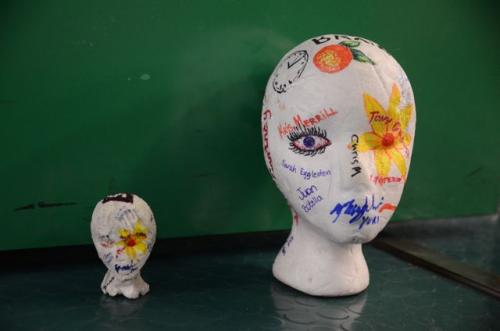
Imagine now that you squeeze very hard one wall of a Styrofoam cup with your fingers . You are applying a big pressure by squeezing with a large force on a small area. You would see that the Styrofoam where you are squeezing becomes thinner as the bubbles burst. The plastic shrinks. Knowing that the plastic shrinks, you could make the whole cup shrink by applying a big pressure everywhere on the cup walls, right? If you were able to do that, you would end up with a smaller cup. The questions is, how can yo apply a large force that is equal everywhere so all the walls shrink the same?
You could step on the cup, which would definitively burst the air bubbles that make up the cup, but the pressure will not be the same at every point of the cup and you will not end up with a smaller cup, but a crushed one. How can you apply a large enough pressure to shrink the Styrofoam that is the the same everywhere?
Since pressure is given by the weight of matter on an area, the atmospheric pressure on top of your head is the weight of all the air above you, applied on the area on top of your head. If you were to dive to the bottom of the ocean, 3000 m in our current location, the pressure on your head would be given by the wight of those 3000 m of water above you, plus the weight of the air above the surface of the ocean. The most interesting thing here is that, even though the the pressure is given by the weight of water and air above you, the pressure is applied in all directions at a given point; up, down, left, right, everywhere!
Problem solved! We only need to send the Styrofoam cups to the bottom of the ocean and the weight of the water above it will squeeze with the same force each Styrofoam bubble in the cup. The cup will return smaller! And that is what we are doing right now as I write these lines. The cups are on their way down attached to the rosette. Here is a picture of the cups that we sent on this cast. We put paper towels inside the cups so they more or less keep the right shape, and place them on a mesh bag. We tie them to the rosette and down they go!
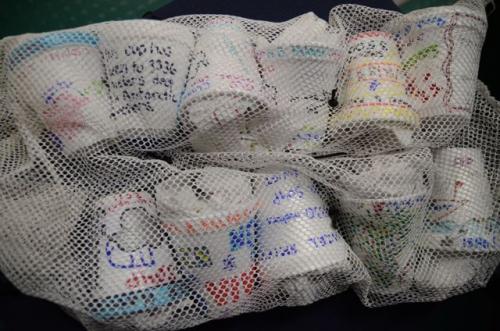
And they have returned! After a 3 hour journey through the depths of the Antarctic waters, the cups are back in the Palmer, cold and wet.
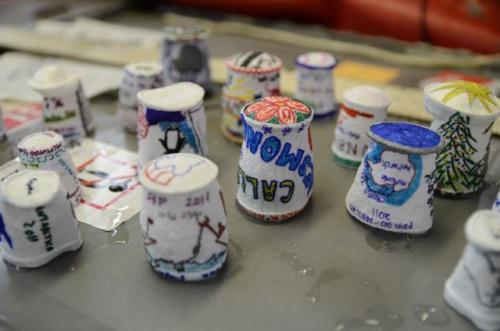
Here are the same two cups for my kids with an un-shrunk cup of the same original size that I will send in the next cast for my wife.
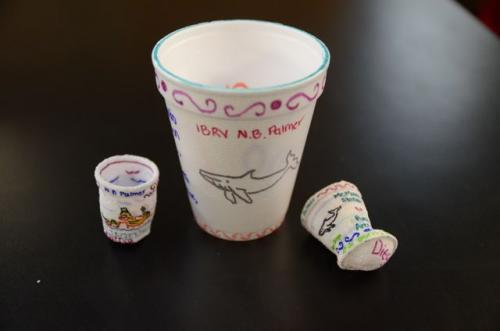
It is also time to give the delayed bad news to the Monona Grove School District community in Wisconsin. If you have read the first entries on this journal, you might know I organized a contest at my school district to decorate Styrofoam cups that would have gone down to the abyss near Antarctica. I took the cups to San Diego, back in November, to be sent on the containers to McMurdo Station, where I would have picked them up and they would be here with me. Somehow, though, the cups did not make it to McMurdo. Jim believes they might still be back at the Scripps Institution of Oceanography. He has promised to take them on a different cruise to shrink them. My apologies to the owners of those cups; they will be shrunk, but not this time.


Comments